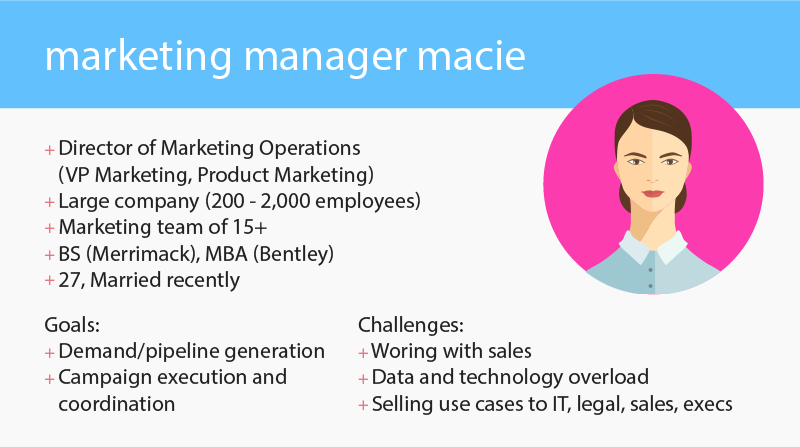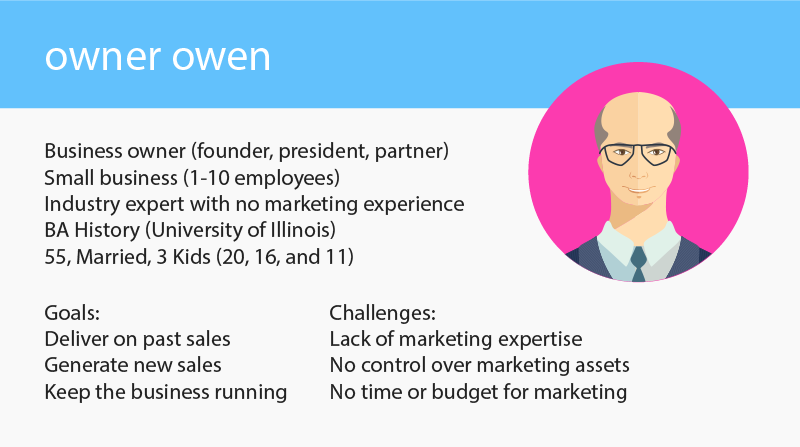When was the last time you took a long hard look at your customer base?
If you answered “I don’t remember” or “never”, it’s time to take your head out of the sand and learn about buyer personas. They are an invaluable asset to your company.
Creating personas for marketing allows you to speak your audience’s language, see where they spend time online, understand their early problems and help solve their challenges. Without personas, you simply can’t properly market to today’s empowered customer, because you don’t know enough about them to be truly helpful.
What is a buyer persona?
 A buyer persona is a fictional, generalized representation of a company’s real and potential customers.
A buyer persona is a fictional, generalized representation of a company’s real and potential customers.
Once you have a clear understanding of who your audience is, it allows you to connect with them better on an emotional level. Buyer personas help provide stronger results from marketing efforts because you know who you’re targeting, where to find them, and what they need.
How do you create a buyer persona?

The first step in creating marketing personas is to gather information on your current customers. Buyer personas shouldn’t be a guessing game. Action and research is required! Real data is essential in creating accurate personas and understanding what really matters to them.
Example questions include:
- What is their job title?
- What type of business do they work for?
- How old are they?
- What challenges/questions were they facing when or even before they reached out to you?
- Where do they go to get their information and news?
Focus the questions around the information you need to know, and tailor them to your organization and industry. If you’re just starting out and don’t have any clients, use educated assumptions and fill in the holes with data as soon as it becomes available.
With these questions answered, begin to create your buyer personas. Review the data and look for trends and similarities between surveys.
While there will be trends, there will also be big differences between clients, which is great. Businesses often have more than one buyer persona. They may have primary personas and secondary personas.
A buyer persona becomes your client’s story. It can be useful to create a visual document of the persona to refer back to. Now that you have an idea of how to create buyer personas, here are five ways they will improve your marketing in a measurable way.
Buyer personas help you connect at the right time, in the right place

Having personas for marketing campaigns is a key part of inbound marketing, which is a client-orientated way of doing business.
It’s about identifying where your customers spend time, so you can be there too. Instead of pushing unwanted ads, inbound revolves around creating educational-based content to help answer a question or solve a challenge.
Your potential customers expect to be able to find you, and easily access the information they need to qualify your product or service on their own.
By reviewing your customer surveys, you can learn their social media habits, where they get their news and what publications they follow. This information helps you choose the right social platforms to advertise on, and tells you where your audience is online, instead of where you “think they might be”.
Personas help you develop remarkable content

Every business wants to write great content. The idea behind inbound marketing is to take that “want” and make it a “need”. Content is the heartbeat of inbound marketing. Without remarkable content, it will be difficult to attract prospects and satisfy their needs.
To create remarkable content, you need a deep understanding of your customers. Knowing what questions they’re asking, challenges they’re facing and solutions they’re seeking are all crucial opportunities to create meaningful content.
Reviewing client surveys will give you this information, but to dive deeper, speak with other departments in your company. Sales people get asked a lot of questions. These are real questions being asked by real people, which will help you focus on the type of content to write.
Remarkable!
Personas are crucial to every stage of marketing
Now that you have created your personas and understand why they’re necessary to a marketing, take your head out of the sand and give it a shake. Since you have real data, you can stop making assumptions about your customer base.
Moving forward, every single marketing initiative will refer back to these personas. We told you they’re important for your business.
Personas are not all alike, which means the way you nurture them through the sales funnel will be different.
For example:
27-year-old Marketing Manager Macie is quite different from 55-year-old Owner Owen. Macie understands the digital space better than Owen, who doesn’t understand his way around social media. Depending on who you’re writing for and what challenges they’re facing, the tone and voice of content would differ.
Marketing is expensive, and you can’t afford to be shooting in the dark, but without creating personas that’s exactly what you’re doing. Having a full understanding of your customer personas will provide you will the knowledge you need to create marketing strategies that are relevant and meaningful.


Personas help you prioritize leads
Personas allow your team to peek inside the minds and lives of potential buyers. They gain insights to help better target customers and pay closer attention to those leads that align with the company’s personas.
When your marketing team knows your buyer personas and where their watering holes are, they can target digital ads there.
Creating personas will make you stand out from your competition

Taking the time to research, build personas and create educational content will help you stand out from your competition.
Companies love to talk about why their business is the best, but few take the time to answer questions prospects are asking. When you focus on your customer base (and their problems), you’re reaching people before they even know they need you. By naming common problems for a prospect and writing about how they can be solved, your company becomes a trustworthy source of information.
When you focus on your customer base (and their problems), you’re reaching people before they even know they need you.
Filling your website with educational-based information shows prospects that you’re different than anyone else out there. Clients will want to click on the content because they hope to find the answers to their questions.
When creating content to stand out from the crowd, ask yourself “Why should my customers care about this?”
Your new blog post… why should they care?
Your Facebook post… why should they care?
Your business newsletter … why should they care?
As you can tell by these five ways listed above, there’s a lot of value focusing on your customer base and not on yourself.
Reviewing and improving your buyer personas

With your buyer personas defined, you now have a much better idea of who your company is targeting.
Just because you’ve built your personas for marketing, doesn’t mean your work is over. Create a plan to review and update your buyer personas throughout the year. When your company changes and improves, your personas will too. You may even discover an entirely new buyer persona as growth happens.
And remember, when your buyer personas grow and evolve, don’t forget to change your marketing campaigns along with them. Personas and remarkable content never leave each other’s sides in inbound marketing. Without one, the other isn’t as powerful.
By aligning your marketing and buyer personas you will see heightened engagement, better landing page conversions and more customers.
Roketto Team
Who the heck is "Roketto Team"? Great question! We use this authorship from time to time for guest writers and previous authors are no longer affiliated with the Roketto brand. What about the cute little rabbit in the Roketto Team avatar? That's Piko, our loveable, space travelling mascot. If this is your first time seeing him, don't worry, it won't be your last. He likes to turn up throughout Roketto's website and content, always looking to help our audience with their marketing needs.













2.png)
2.png)









